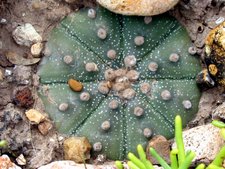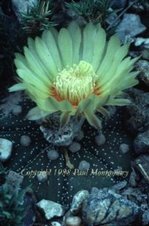Week 13
The complete classification of the Star Cactus is as follows:
Kingdom: Plantae
Phylum: Anthophyta
Class: Dicotyledoneae
Order: Caryophyllales
Family: Cactaceae
Genus: Astrophytum
Species: Asterias
Star cactus is a rounded cactus that lives in the ground. It has been changing in different matter. This Star Cactus is nicely adapted to its habitat. Three examples of its adaptations are: Its color and shape helps it to camouflage itself from predators that threat it. Its way of reproduction, permits to reproduce with another mates near by. They use pollination to reproduce. Since it is on the ground, it absorbs nutrients from the soil to feed. Also, it uses sun light, which means that they are photosynthetic and can produce their own food. I have chosen its reproduction as a target for selective breeding. We can use some samples of pollen to produce more pollen and mixed with another cactus that are widespread in another regions where they are. We can complete these breeding and produce more specimens and increase the population of Star Cactus. We can increase the population of Star Cactus and make it part of our nursery, and we can sell this beautiful plants to collectors; providing specimens will decrease the sell of this plants on the black market or illegal selling of the plant. People can buy these cactuses and have them at home in their own garden. Its habitat is very limited and rare. They life in deserted areas where there is little or no vegetation around them. Texas and some parts of Mexico are the best places to find them. we can start our project breeding four or six species in our nursery, and, then, put them back in their habitat so they can continue reproducing with another species. Planning this experiment I realized that we may come out with another new different species. If we nurse the cactus in our nursery, the risk exist that the cactus will mate with another plant different than the cactus. I can see some potential benefits to this work, but I also have some ethical concerns. Some good things would be that we can make some money out of this. Also, that we can improve the breeding of the Star Cactus and lower the illegal sell of this product; at the same time, we will create more species and help protect them. On the other hand, we may affect the reproduction of the specie because we are going to extract some species from the habitat and this may affect the reproduction.
Week 10 A-A-S
To the Society for the Conservation of Star Cactus
Scientists and conservationists can use DNA analysis or examples to determine the compatibility of the Star Cactus with another types of cactus. DNA can be the solution to preserve this beautiful plant. If we can find another plants that live with a similar genetic codes, then we can mix these plants with Star Cactus and have the possibility to preserve this beautiful plant. Civilians, urbanizing, and black market sellers are the cause of this plant to be almost extinct.
As I read the journal called: “What’s black and white and fluffy all over?” I conclude that this journal can be the sample to conserve Star Cactus. As this journal explains how scientists are experimenting (mating) this peculiar animal, I think that this can be the solution for the reproduction of Star Cactus. This process will be similar to the one of artificial insemination. Mixing the genes of this species with the other, and having a product as a consequence, another Star Cactus.
To the Society for the Genetic Modification of the Star Cactus
Modifications on the Star Cactus’ DNA will improve their reproduction in great manner. Increasing the chances for the Star Cactus to survive and stay away from extinction. You should use the reproduction gene called Melinae, a gene that contributes to reproduction of several species. This gene is in the Star Cactus and it can be placed in more plants to produce reproduction.
As a result of making this crossing between some Star Cactus and another Star Cactus or the compatible plants will increase the population of the Star Cactus, taking it away from extinction. But also, we need to make sure that we use the correct specimens, because we may cause a terrible mistake if we do not cross the plant as we need to; causing the Star Cactus to be deform.
Star Cactus
Hello everyone, my name is Luis Hernandez, and today I am reporting from the hot southwest of Texas. I am a student at Sam Houston State University. The purpose of this assignment is to introduce to all of you endangered and/or threatened species native to Texas, specifically the Star Cactus (Astrophytum asterias).
This endangered specie is originally from Southwest, Texas, at the city of Rio Grande, Texas. It belongs to the Domain: Eukarya and the Kingdom: Plantae. This is a flowering plant. “Its flowers are yellow with orange center, and 2-3 inches in diameter. The fruit is an oval, fleshy berry, up to half an inch in length. The green, pink, or grayish-red fruit is covered with dense, wooly hairs. During periods of adequate moisture, star cactus is usually a dull green color; however, during droughts, the cactus becomes brown and loses fullness so that it is flush with the ground and almost perfectly camouflaged.” (2)
Star Cactus (Astrophytum asterias) is a terrestrial plant. It is most likely to be in desert-like areas and is only 1-2 inches tall. “Star Cactus grows on sparsely vegetated areas in gravelly, saline clays or loams at low elevations in the Rio Grande Plains
Historically, Star Cactus was known from Cameron, Hidalgo, and Starr Counties in south Texas, and the border states of Nuevo Leon and Tamaulipas in Mexico. Presently, this species is known from one population each in Starr County and Tamaulipas.”(2)
It obtains its food by photosynthesis and reproduces by pollination. I did not find evidence of bioprospectors’ interest on this plant, but I think that they may want to research more on this plant since it produces a fruit. I did not found any evidence of damage to this plant because of global warming. But I do not think that global warming will cause damage to the Star Cactus, because this plant mostly lives in warm and dry regions. This specie is now ENDANGERED and it needs help from us in order to stay on our planet. This specie is hardly threatened by collectors and civilians. Since lands are becoming urbanized and land that transforms into agricultural fields are destroying its habitat.
People can help to conserve these plants by not collecting this plant from the wild. Instead, it people wants to get these cactuses, they should obtain them from nurseries and not from their original land.
Pictures:
http://www.nature.org/wherewework/northamerica/states/texas/images/lasestrellas1.jpg
http://www.tpwd.state.tx.us/huntwild/wild/species/starcac/
Websites:
http://ecos.fws.gov/speciesProfile/SpeciesReport.do?spcode=Q07V
http://www.tpwd.state.tx.us/huntwild/wild/species/starcac/
http://www.iucnredlist.org/search/details.php/40961/summ

